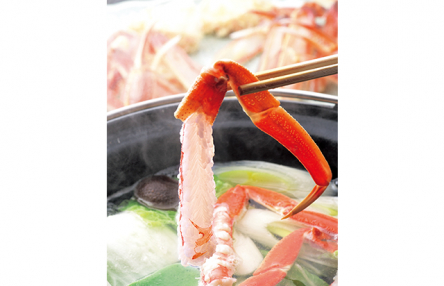
- FOOD
- 2020.04.29
Bento: Boxing up happiness―1
While staying in, how about enjoying some time in the kitchen to create a bento lunch for a picnic at home? Chef Masahiro Kasahara of the popular restaurant Sanpi-Ryoron offers recipes for these hearty washoku bento, along with bento-making tips. Open up a bento box and delight in the variety of flavors and colors you discover.
Recipes and preparation by Masahiro Kasahara. Styling and text by Atsuko Sakamoto.
Bento accessories from Utuwa
<Look for more recipes in the Kateigaho International Japan Edition 2015 Spring/Summer feature.>
Hinomaru bento
Most Japanese associate the classic Hinomaru bento—so named because it calls to mind the Hinomaru, or Japanese flag—with a square bed of white rice topped by a red umeboshi plum. The original version, according to Kasahara, “consisted of rice and umeboshi, plain and simple. Today’s bento, with their colorful side dishes, are a much fancier version.” Grilled salted salmon and rolled omelet, simple mainstays of Japanese cuisine, complement this most orthodox of bento (above photo).
Recipe (Makes 2 servings)
• 400 g cooked rice
• 2 umeboshi pickled plums
SIDE DISH 1
Grilled salted salmon
• 2 fillets (80–100 g each) salmon
• Salt
1. Salt each salmon fillet on both sides and let stand for 15 minutes. Blot moisture with a paper towel.
2. Grill the salmon until cooked through.
SIDE DISH 2
Kinpira gobo
• 100 g gobo burdock root
• 80 g carrot
• 1 Tbsp salad oil
• Seasoning sauce:
3 Tbsp sake
2 Tbsp dark soy sauce
1 Tbsp sugar
• 1 Tbsp white sesame seeds
• Dried red chili pepper flakes, to taste
1. Peel burdock and carrot and cut julienne-style into thin 4 cm strips.
2. Heat salad oil in frying pan over medium-high heat and sauté burdock and carrot until tender. Add seasoning sauce and continue sautéing until the liquid is nearly gone.
Remove from heat. Sprinkle sesame seeds and red chili pepper flakes over the vegetables and mix gently.
SIDE DISH 3
Dashimaki rolled omelet
• 3 eggs
• Seasoning sauce:
45 ml dashi stock
1 tsp light soy sauce
1 Tbsp sugar
• 2 Tbsp salad oil
1. Break eggs into bowl and whisk lightly. Add seasoning sauce and mix thoroughly.
2. Place a rectangular omelet pan over medium heat. Add salad oil to coat the pan surface thoroughly. Pour the excess oil out into a container, reserving for use as needed during cooking.
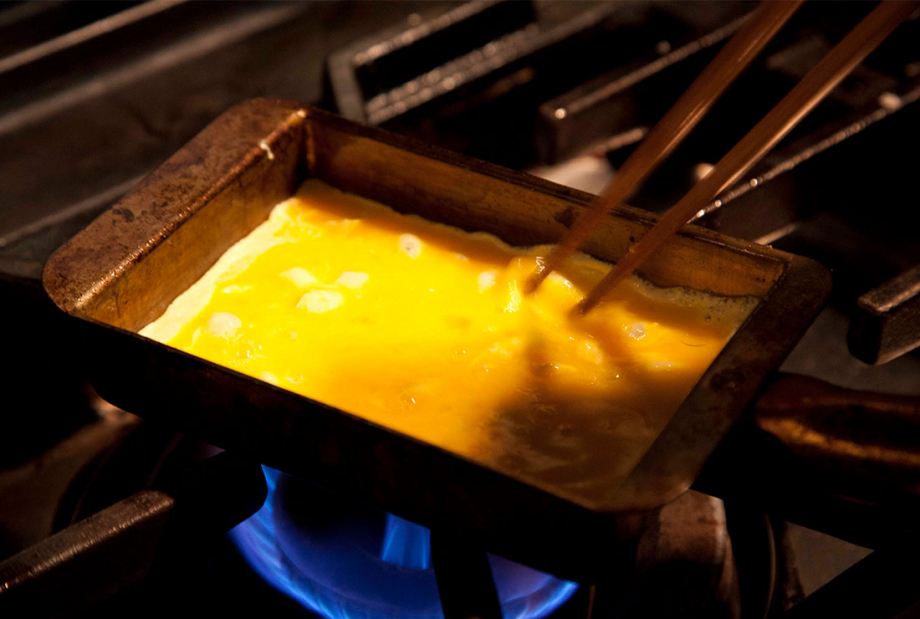
3. Pour a third of the egg mixture into the pan to make an even layer, popping any bubbles that may form.
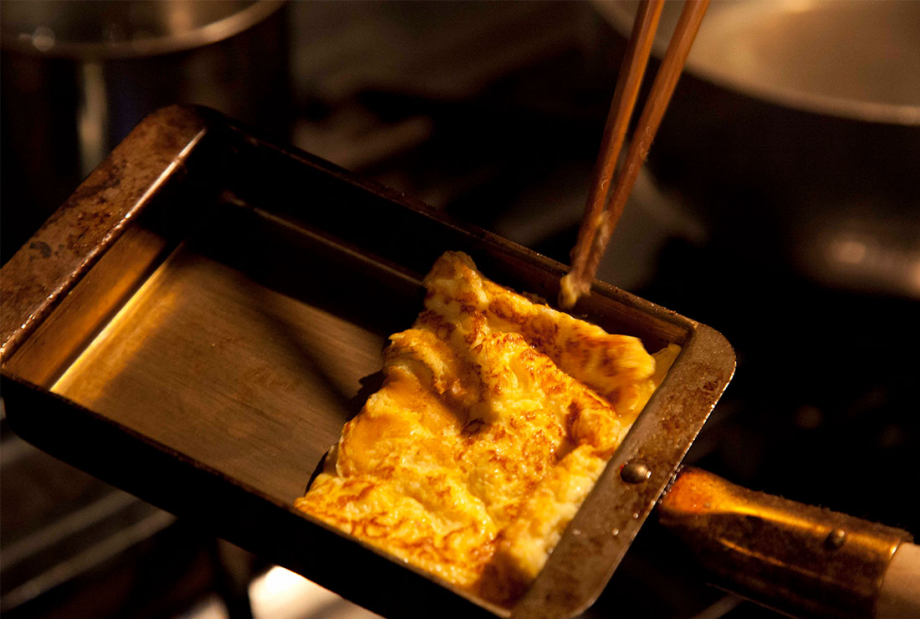
4. When the egg has set but is not yet firm, fold in half from the back of the pan to the front.
5. Coat the empty surface at the back of the pan with salad oil, then slide the folded egg to the rear.
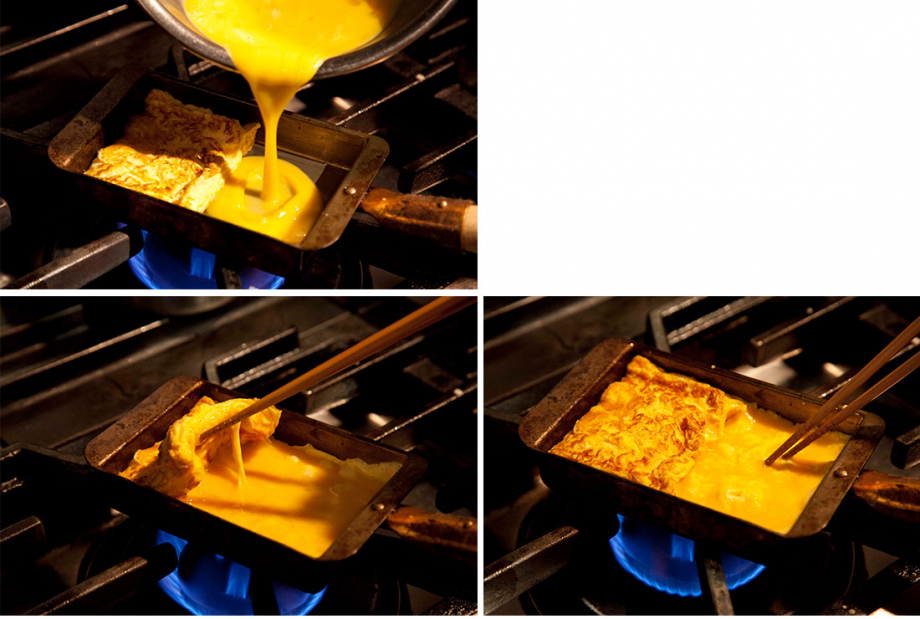
6. Coat the empty surface at the front of the pan with oil and pour in another third of the egg mixture. Lift the cooked egg at the back of the pan slightly so that the new egg mixture flows underneath. When the egg begins to set, fold and move as before, oiling the pan again as needed.
7. Repeat the process with the last third of the egg mixture.

8. After folding for the last time, press the omelet firmly into the corners of the pan to make an even rectangle. Once the omelet has cooled, cut to fit the height of the bento box.
SIDE DISH 4
Sesame-dressed asparagus
• 2 asparagus stalks
• Salted boiling water for blanching
• Dressing:
1 Tbsp ground sesame seeds
1 Tbsp dark soy sauce
1 tsp sugar
1. Cut the base off each asparagus stalk and peel about a third of the way up from the bottom. Cut on the diagonal into bite-sized pieces.
2. Blanch asparagus in boiling water until just tender. Drain well and allow to cool.
3. Stir dressing ingredients together. Combine asparagus and dressing and mix gently.
SIDE DISH 5
Kombu tsukudani
Note: This recipe calls for cooked kombu. This is a good use for kombu left over after making dashi stock; you can also use quick-cooking kombu.
• 100 g cooked kombu
• 2 Tbsp whole sansho prickly-ash berries, boiled
• Seasoning sauce:
800 ml water
2 Tbsp vinegar
100 ml dark soy sauce
50 g sugar
1. Cut kombu into 3 cm squares.
2. Combine seasoning sauce ingredients, kombu, and sansho in a saucepan over high heat and bring to a boil, skimming off any foam from the surface. Reduce heat to low and cover with a drop lid. Simmer for 2 hours until liquid is nearly gone.
Assemble the bento following the step-by-step tips, below.
Tips from Chef Kasahara on making your bento attractive
“Bento should not only taste good, but also be enjoyable to eat,” says Kasahara. “The trick is to decide on the main item to feature in the bento and balance that out with a few side dishes.” Here’s a basic guide for assembling the Hinomaru bento, along with general tips for bento-making.
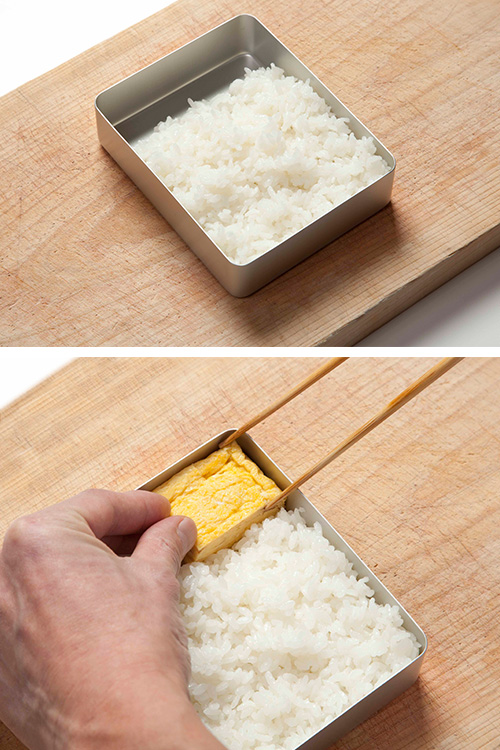
1. Pack the rice into the bento box while it’s still hot. Pile the rice high at the front of the box, but lower toward the back, to allow ample space for the side dishes.
*Hot rice is easier to pack, as it easily fills in the corners of the bento box.
2. Place the dashimaki rolled omelet in the upper right-hand corner.
*Place solid, square items in the corners.
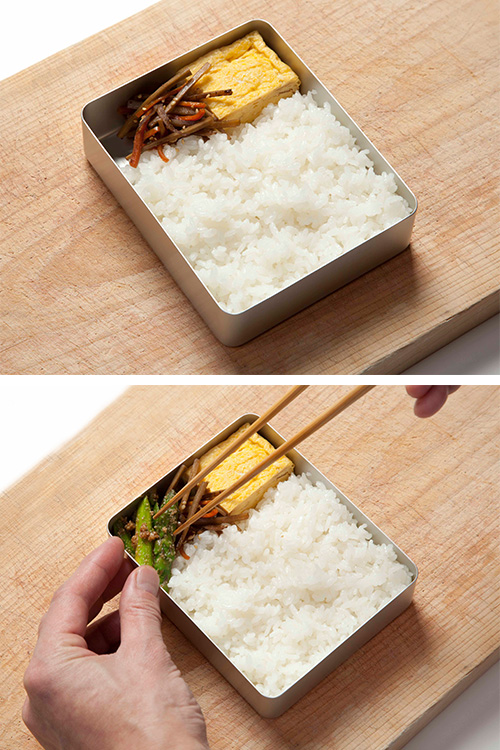
3. Arrange the kinpira gobo (sautéed and simmered burdock) next to the rolled omelet.
4. Put the sesame-dressed asparagus in the upper left-hand corner. Arranged side by side, these components will fill the empty space at the top of the bento box.
*Foods with flexible shapes are useful for filling in gaps.
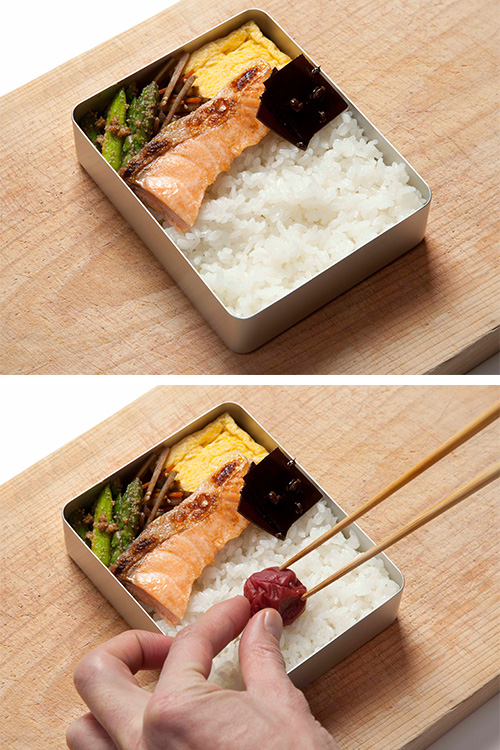
5. Lay the grilled salmon on top of the rice.
*The main item or colorful foods should be placed toward the top or the center of the bento box.
6. Add the kombu tsukudani (soy-simmered kelp).
*The overall color palette will be more appealing if similar-colored foods are kept separate.
7. Place the umeboshi on the rice, and your Hinomaru bento is complete!
<Creating the perfect bento: the basics>
1. Choose lean meat. Fatty meat has less appeal at room temperature.
2. Use vegetable oil for sautéing; butter hardens when it cools.
3. Make sure all heated ingredients have been cooked completely.
4. Bento components should not be too moist. Excess sauce or dressing can seep into the rice and other dishes, muddying the flavors and detracting from the bento’s appearance, or even causing spoilage. Runny foods should be packed in separate containers, or in foil or silicone cups.
5. Blot excess oil and moisture from foods with a paper towel before packing. This will keep fried items crisp even when they have cooled.
6. Make sure all bento ingredients are cool before closing the box lid. Condensation can also cause spoiling.

Masahiro Kasahara
Kasahara, a Tokyo native, trained for nine years at Shogatsuya Kitcho before taking over his family’s yakitori restaurant. In 2004, he opened Sanpi-Ryoron, which soon became one of the hottest eateries in Tokyo. He has also opened other locations in Nagoya and Kanazawa. Considered a rising star of Japanese cuisine, Kasahara frequently appears on television and other media.
www.sanpi-ryoron.com
<Enjoy more recipes in Part 2.>



